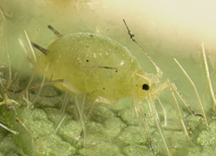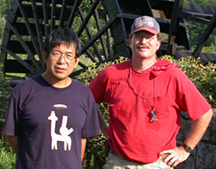
May 13, 2005
Bob O'Neil will be available for interviews through June.
Almost invisible destructive insect sends researchers to the Far East
WEST LAFAYETTE, Ind. - The list of enemies is made, and now Purdue University researchers must find the most lethal one by returning to the target's native home in the Orient.

|
The object of this far-flung investigation is to determine safe and effective natural predators of the almost microscopic, nearly transparent yellow-green soybean aphid, which can cause an average crop yield loss of six to eight bushels per acre. The project to discover insects that control soybean aphids in Japan, China and Korea where they originated is a collaboration of Purdue, the University of Wisconsin, Michigan State University, the University of Minnesota, Iowa State University, the University of Illinois, the Illinois Natural History Survey and the U.S. Department of Agriculture. The scientists already have found nine species that kill soybean aphids.
"In most of Asia, the soybean aphid is not a problem, even though it collects on the plants, because natural enemies control it," said Bob O'Neil, Purdue entomology professor. "We have studied the soybean aphid's natural enemies and now that we know them, we need to determine their impact on non-targeted insects."

|
The soybean aphid, which first appeared in the United State in 2000, has some enemies already at work in this country, including many native and at least one non-native, the Asian lady beetle. Unfortunately, the beetle has become an unwelcome guest in homes throughout the Midwest and other parts of the country. The biological control for which researchers currently are searching are insects that will rid the fields of the soybean aphid without harming other plants, ecologically important insects, or becoming a nuisance.
Because of the problems associated with the Asian lady beetle and others, researchers are paying more attention to the consequences of introducing new natural enemies, O'Neil said. In addition to the laboratory testing, the first limited releases of such species are conducted within cages.
"We don't want to bring in species that will have a significant negative impact on species other than the soybean aphid," O'Neil said. "We have nine soybean aphid enemies that we identified on previous trips to Japan, China and Korea. They are quarantined at the University of Minnesota and the USDA Agricultural Research Service lab in Newark, Del. We have tested them in the lab to begin to understand their impact.
"This summer, we return to the Far East to find out the other things these natural enemies attack. In Asia, the spraying for soybean aphids is very limited because these natural enemies provide most of the control, saving thousands and thousands of dollars over the cost of pesticides."
Biological control also means less chemical residue on crops due to spraying, he said.
The organisms that generally kill aphids have an interesting modus operandi.
"Most of the soybean aphid's natural enemies we are studying are parasites," O'Neil said. "They lay their eggs inside the aphids. The egg hatches into a little maggot-like larva, which eventually pupates, turning the living aphid into a mummy. A new adult parasite emerges from the pupa/mummy, and the cycle continues.
"If you've seen the movie 'Alien,' you have the general idea of the parasitic lifestyle of these insects."
Soybean aphids are about the size of a pinhead and are difficult to distinguish from other ecologically important aphids unless they are looked at with magnification. On the tip of the soybean aphid's abdomen are black tailpipes called cornicles.
The tiny plant-damaging insect lives on the leaves of young soybean plants causing yellowing and malformation of the leaves. As the plant grows, the aphid moves to the stem and other plant parts and prevents the plants from growing to normal size. Aphid damage occurs because the insect inserts its slender beaklike feeding apparatus into the plant tissues to suck out the sap.
In addition to the aphid's direct damage to the plant, the insect also can transmit viruses that cause leaves to have a mottled or mosaic look, leaf distortion, reduced number of pods, deformed pods and discolored seeds. Besides damage to soybeans, the aphid also visits other crops, such as snap beans and potatoes, and has been associated with virus transmission in those plants.
There are about 8,000 species of aphids, including approximately 800 in the Midwestern United States. Some of the species are important to the life cycles of other plants and animals, O'Neil said.
"We don't want to do harm to insects that aren't doing us harm," O'Neil said. "If an aphid species is native to the area, then there is probably a reason for it to be here."
The insects to worry about are invasive species such as the soybean aphid that migrated from different parts of the world and don't have natural enemies in their new habitat, he said.
Researchers will spend weeks in Japan and China evaluating the soybean aphid enemies before they try a limited release of one of them in the United States, O'Neil said.
The North Central Soybean Research Program provides funding for this research.
Writer: Susan A. Steeves, (765) 496-7481, ssteeves@purdue.edu
Source: Robert O'Neil, (765) (765) 494-7207, rjoneil@purdue.edu
Ag Communications: (765) 494-2722;
Beth Forbes, forbes@purdue.edu
Agriculture News Page
Related Web sites:
Purdue Department of Entomology
PHOTO CAPTIONS:
Soybean aphids have a complex life cycle. For example, wingless adult females later develop wings that allow them to migrate in the spring and fall. The complete soybean aphid life cycle includes 15 to 18 generations annually. (Purdue University Photo by Ho Jung Yoo)
A publication-quality photo is available at https://www.purdue.edu/uns/uns/images/ +2005/oneil.soybeanaphid.jpg
Purdue University entomologist Bob O'Neil (right) travels to the Far East to study natural enemies of the soybean aphid. He works with researchers such as Wada Takashi (left) of the Kyushu-Okinawa Agricultural Experiment Station in Kamamoto, Japan, a collaboration of scientists from American universities, the U.S. Department of Agriculture and the Illinois Natural History Survey. (Photo courtesy of Bob O'Neil)
A publication-quality photo is available at https://www.purdue.edu/uns/uns/images/+2005/oneil.soybeanaphid2.jpg
To the News Service home page